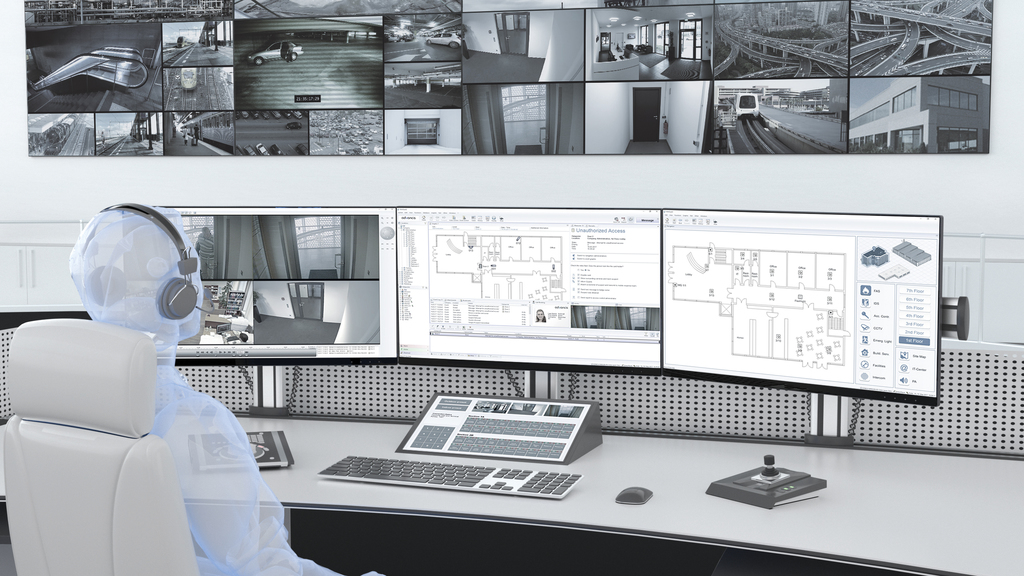
Brian Sims
Editor

Brian Sims
Editor
Andre Meiswinkel explores how to simplify system integration into a vendor-neutral physical security information management (PSIM) platform and what added value can be created in the planning phase.
FULLY INTEGRATED buildings require interdisciplinary communications between individual systems so that they can be used together, for example CCTV, fire alarm, access control and any other technical systems.
This has the result of making the planning stages for individual systems more complex since the building consultant has to consider how physical security is guaranteed but also how should all technical systems be integrated into the IT infrastructure (cyber security) and especially to comprehend and design what operational processes will take place in the finished building.
Homogeneous concepts are required
A vendor-neutral PSIM platform offers a holistic and cost-efficient integration solution, since it manages all security systems, building automation and information technology via a unified user interface. Each subsystem, such as fire and intrusion alarm systems, access control, video surveillance or building management is fully integrated into the management platform via proprietary interfaces or standard protocols.
Open integration PSIM platforms centralise real-time incidents from disparate security and information systems and display them using intelligent event visualisation tools that enable the operator to easily identify situations. With the help of automatic actions and dynamic workflows, users are guided to the most appropriate response method in accordance with established guidelines for each incident or alarm type.
Interaction of technical systems
Using a PSIM platform means that the connected subsystems interact in case of an incident: for example, in the event of an unauthorised door access attempt the software will display the alarm event message and automatically provide relevant cardholder data such as name, photo and transaction history. Local CCTV cameras will also automatically be displayed on screen thus helping the control desk operator to evaluate the situation. The PSIM platform provides the user with floor plans, maps and step by step handling instructions that lead them through the required actions for a quick and secure outcome of the situation.
All actions such as event messages and user entries, video clips, photos or related documents for an event are logged in a data archive which facilitates the post event creation and display of reports and evaluations. As such it is very easy to provide an overview of relevant key statistics for all connected systems and the control centre.
Integration and interoperability between the connected subsystems are achieved by developing specific driver interfaces or by using standard open protocols that are widely available in the industry. These open integration solutions allow users to futureproof technical infrastructures, by ensuring that customers are never vendor locked and remain free to add new technologies or replace older systems at any time during a project’s lifecycle. Vendor-neutrality is the key word, as PSIM providers are independent businesses that work closely in partnership with security system manufacturers, but never in direct competition.
Simplified planning
How should early stage project planning validate that system interaction will actually work and thus design ideal incident management processes?
Building Information Modelling (BIM) can be helpful here. This method is applied for optimised building planning using special software which directly takes over changes during the planning phase for all relevant data, so that dimensions as well as quantities and costs are adapted automatically. This does not only apply during the planning process, but also for the entire life cycle of a building. The aim is to design a project efficiently and sustainably using integral planning. Planning deficiencies and miscommunication as well as wrong interaction between systems are avoided from the outset and communication between all project participants is improved. This requires a close exchange between all involved planners.
BIM simplifies PSIM implementation planning, for example with the exact placement of data points and integration of all technical subsystems as well as incident processes already predefined.
Special requirements
It is important to have an experienced specialist consultant and enter close dialogue with the end customer during the planning phase and to bring his requirements into a functional tender.
In addition to quantitative information (e.g. 30 cameras, 350 fire detectors, 30 doors for access control), this tender should in particular include qualitative descriptions of the processes as well as the functional security objectives of the end user. These aspects are not yet completely achieved via BIM.
To optimise and simplify the integration process of a PSIM platform, the integrator should know the end customer requirements in detail. Manufacturer support is crucial in providing the option for optimal implementation and custom configuration. A good PSIM manufacturer will support both the integrator and the end customer during the planning phase: a visit to the project site and control centre helps to identify any specific challenges for dynamic workflows (PSIM incident management and step by step handling for operators) since these are defined and designed individually. This also enables to estimate related expenses at an early stage and helps the PSIM manufacturer understand what functional enhancements and individual components might be needed.
After completion of the extensive preliminary planning there are commissioning and acceptance phases. In case of a layered PSIM platform the effort to integrate the individual technical systems is often so complex that the integrator must have highly specialised knowledge. In addition, the PSIM platform should meet any special conditions and individual work processes on site, such as follow established communication procedures so that event processing can be realised in an optimal way later. At the same time, it is important that the PSIM platform is flexible and easy to use for the operator.
Process optimisation during operation
Once a project has reached the operational phase it will become apparent how the planned processes stand up to actual requirements. Experience has proven that despite the best planning further adjustments are often still required. PSIM platforms are by nature open and flexible which allows for continuous enhancements and the fact that improvements can still be made should not be considered as a planning failure (even when this represents a project overrun), but rather keep in mind the final goal which should be the complete optimisation of business processes.
A POC (Proof of Concept) in advance can be helpful, for which PSIM manufacturers and integrators are generally willing to do. The end customer would specify concrete scenarios that have to be demonstrated using the PSIM platform, for example a connected system generates an alarm, the platform displays the event, initiates automatic actions, automatically interacts with other linked systems, displays individual operator workflows to solve the situation, records all actions taken and generates reports and forensic evaluations (for preservation of evidence). The execution of a POC means considerable additional effort for all bidders in the planning phase, where costs should be covered by the end user, but this contributes significantly to decision making for choosing the most suitable management platform and usually also considerably reduces later additional workloads for process optimisation.
Finally, all project participants are challenged: The manufacturers of the individual technical systems, the manufacturer of the PSIM platform, the integrator and the end user, but in particular the technical consultant who has to ensure optimum coordination and communication between all involved parties in the planning phases.
Andre Meiswinkel is COO at Advancis Software & Services GmbH. For more information, visit www.advancis.net



Advancis Software & Services GmbH
Monzastr. 1
Langen
Germany
DE-63225
GERMANY
0049 6103807350